Links to identify nutrients deficiencies & cheapest fertilizer
I posted several links to identify nutrients deficiencies in plants, but they are scattered all over this forum, so I organize them in this thread.
Balanced & low-dose fertilizer is the best approach to prevent nutrients deficiencies. Tomato Tone NPK 3-4-6 is sold out at Walmart, but they still have Plant tone NPK 5-3-3, big bag for $10 each. I'll go ahead and order Tomato Tone from Amazon, $8.47 per bag, but free shipping for orders over $35. Good deal with 4 bags with free shipping.
I checked my tomatoes in front: 100% healthy, no yellow leaves. I fixed that soil with lots of gypsum, plus 1 cup of tomato tone ... I don't water that bed. The tomatoes in my back yard have yellow-margins on lowest leaves, typical of potassium deficiency. I used Jobes NPK 2-7-4, and NOT enough gypsum. I should had used Tomato-Tone with NPK 3-4-6 instead.
Below link is excellent, it identifies what becomes deficient when a particular nutrient is supplied in excess. When calcium is used in excess, will induce deficiencies in potassium and boron. Here's my experiment of throwing gritty lime on one tomato plant, it immediately shows potassium deficiency: lower leaves have yellowish margins, from excess calcium and raising the pH:
Here is a link that might be useful: What's in excess can produce deficiencies
This post was edited by Strawberryhill on Fri, Jul 11, 14 at 17:08
Comments (56)
jim1961 / Central Pennsylvania / Zone 6
9 years agolast modified: 9 years agoThat "corn meal bouquet" looks fantastic! All the blooms look show-room new!
Wow those leaves are shiny on Bolero....enchantedrose
9 years agolast modified: 9 years agoHi Strawberry, thanks for this post with all of your data available in one place :-)
For the corn "tea" do you throw the solids away or compost them? I'm still having trouble with the chipmunks digging tunnels around my roses, even the used cat litter isn't a deterrent so I can't use the cracked corn in the planting hole. I'm so glad that I can use my 50lb bag of cracked corn now and not have to use it for squirrel food!
The roses are enjoying the cool weather we've been having, we have a high of 83 this week just for one day the rest are high 70's so perfect gardening weather.
SharonRelated Professionals
Elgin Landscape Contractors · Annandale Landscape Contractors · Bound Brook Landscape Contractors · Clearlake Landscape Contractors · Cliffside Park Landscape Contractors · Firestone Landscape Contractors · Gaithersburg Landscape Contractors · Kaysville Landscape Contractors · Lakewood Landscape Contractors · Monterey Landscape Contractors · New Providence Landscape Contractors · Pacifica Landscape Contractors · Stony Brook Landscape Contractors · Thonotosassa Landscape Contractors · Waterford Landscape Contractorsstrawchicago z5
Original Author9 years agolast modified: 9 years agoHi Sharon: I will pH-test 1/4 cup of cracked corn soak in 2-gallon bucket to see if it's too acidic, compared to rain water. Will let you know later. Birds like to eat the solids .. I dump them in a reserved spot, so even if they sprout, it's easy to pull them up.
Chipmunks caused trouble here for the past years: They dug into my pots. This year they leave my pots alone, because I put red-lava rocks on top. My neighbor traps them & kill them. He taught me a trick: Use 5-gallon bucket, fill 1/2 with water, float some flat-big-black sunflower seeds (bird-feed), put a shovel up as a ladder leaning against the top of the bucket. Lots of chipmunks drowned when they jumped down to get the seeds.
Cracked corn in a 5-gallon might work to trap chipmunks, but I still have a bag of black-sunflower seeds to use. Acidic cracked corn is the best moisture-retention I have seen, if mixed in planting hole in LATE FALL & neutralized with something alkaline. I dug those holes up this summer, and they are very moist, compared to my heavy clay.
Second best moisture-retention is leaves, and last is peat moss. Leaves are initially acidic, I already tested that in red-cabbage juice, the pH is around 4. However, once organic matter like leaves and cracked corn become fully decomposed, the pH becomes neutral.
In this hot weather, I notice how the roses without gypsum in the planting hole are wilting. Gypsum in the planting helps with drought ... calcium helps plant to retain water better. Calcium increases nitrogen-absorption .. so I remind myself to throw some granular gypsum when I apply Milorganite.
My open compost of kitchen scraps help to keep animals away from my roses. Previous years with deer eating my roses: Hubby bought me a huge container of curry powder, less than $3 from the Mexican store, plus a $2 bottle of ground clove. Works great if kept away from leaves ... curry powder burns. I sprinkled that on the ground, and deer & rabbits left my roses alone.
The raw eggs & fish sauce bottle is to make it super stinky for deer. For rabbits, curry powder and clove work well. I already tested garlic powder and cayenne pepper, plus Irish Spring Soap ... none were effective !!!
enchantedrose
9 years agolast modified: 9 years agoHi Strawberry, thanks.
We don't seem to have much of a problem with deer or rabbits. We live in a very rural farm area. Our street is 1/2 mile long with only 11 houses. We are surrounded by swamps, fields and woods so I think the deer and rabbits can find enough to eat. The chipmunks are lazy though, they much prefer the cracked corn and bird seed as do the squirrels. We are not really overrun with them, I think there might be 3 or 4, but they do love that cracked corn!! I'll try your spice deterrents or lava rocks to see if this helps.What are you using for gypsum? Do you also top dress with it once the rose is planted? I assume that you don't dig your roses up every year to refertilize? The Epsoma is pretty pricey.
Sharonstrawchicago z5
Original Author9 years agolast modified: 9 years agoHi Sharon: Thank you very much for that link. Predfern in my Chicagoland sent me a link to U. of. Illinois which documented that the final pH of fully decomposed leaves is slightly alkaline. I lost that link, and I'm glad that your link also states that once organic matter decomposes fully, it's alkaline. An excerpt from the link you provided:
"Bark (Hardwood):Shredded hardwood bark is one of the most popular mulches used in landscape plantings. It is a byproduct of the paper and lumber industries that can be recycled as a mulch. Its pH is slightly alkaline ... Bark (Softwood):Chunk pine, fir, and redwood barks are the most popular types. This material is acidic."
The soil research, entitled, "Contrasting soil pH effects on fungal and bacterial growth" is right about "The growth-based measurements revealed a fivefold DECREASE in bacterial growth and a fivefold INCREASE in fungal growth with lower pH." In our month-long rain & humid weather, I notice that mushrooms grow everywhere: on the lawn, on the $$$ dark mulch, on cypress mulch .... but NO mushroom on the red-dyed hardwood mulch, since the pH is alkaline.
Recently I got some old grapefruit, so I squeezed that to lower my high pH water .... some roses immediately broke out in black spots. I don't mind a bit of BS, if my roses bloom better and stay compact. That's much better than previous years of 100% clean roses, very few blooms, and vigorous growth which I had to trim & bagged them. When the pH is high, only nitrogen gets through, but phosphorus and potassium are bound up with calcium hydroxide in tap.
Below USAgypsum link sells gypsum at 10 lb. for $11.35 (shipping included). Also 40 lbs. for $6.99, but shipping cost will be added. It's 1/2 the price of Kelp4Less at $12 per 5 lb. I use granular gypsum sold cheap at Menards, it's slower-release & safe to apply 1/4 cup on top around roses, if balanced with equal ratio of potassium. The red-lava rocks I put on top supply plenty of potassium, so I don't even bother with sulfate of potash.
For the planting hole of Annie L. McDowell rose, which prefers acidic, I used 3 cups of GRANULAR gypsum to lower my clay pH. Annie can take lots of acid without breaking in black spots. When I first got Annie, she was wilting in hot sun, or blooms balled in the rain. I fixed both problems through gypsum application. Below is Annie, taken today, hot & humid, still clean after I gave grapefruit & tap water. It's right next to my limestone-based patio.
Here is a link that might be useful: USAgypsum: buy gypsum in bulk
strawchicago z5
Original Author9 years agolast modified: 9 years agoThe rose park nearby uses lots of chemical fertilizer, but they have alkaline tap-water, so their grafted Austin roses get huge & stingy when there's no rain. pH of rain is slightly acidic in my Chicagoland, but more acidic in the East Coast at 5.6.
Last summer I used few tablespoons of gypsum per 5-gallon bucket to lower the pH of my tap. But I had to stir the bucket to dissolve, used-citrus fruits is faster to lower the pH of my tap water at 8.3. Next time I use less grapefruit, spread some Milorganite for more leaves, plus gypsum (calcium sulfate) to buffer the acidity of grapefruit.
Here's the result of lowering my tap water pH with grapefruit. Citrus fruits have vitamin C, which is essential for plant's growth (see link below). Wise Portia broke out with black spots on lowest leaves, but I get tons of blooms, thanks to lowering the pH of my alkaline tap from 8.3 to slightly acidic, so potassium and phosphorus can be released.
Here is a link that might be useful: Effects of vitamins on plant growth
This post was edited by Strawberryhill on Tue, Jul 22, 14 at 9:53
strawchicago z5
Original Author9 years agolast modified: 9 years agoChristopher Marlowe next to it, didn't get grapefruit, thus less blooms, more pale, clean and bushier with more leaves. I put lots of red-lava rocks at the bottom. Without high-potassium rocks, Christopher is stingy at such high soil pH. In my experiments in lowering my tap water, I like the result of soaking cracked-corn in water the most, resulting in the best health and best blooms. Will try "corn-tea" on Christopher next, once I test the pH with red-cabbage juice.
Picture taken today July 22, hot & humid, only red-lava rocks, and chicken manure early summer. Picture is the end of is very long 1st flush:
This post was edited by Strawberryhill on Tue, Jul 22, 14 at 12:36
strawchicago z5
Original Author9 years agolast modified: 9 years agoI look through pics. of my roses for the past years, best health was with PLANT-BASED SOLUBLE fertilizer such as alfalfa tea and corn-tea. I marveled at my neighbor's tomato plants, fertilized with soy-based, low-salt Daniels liquid fertilizer.
The years with horse manure plus alfalfa produced shiny leaves & health. The horse manure made the surface dry and alkaline, and the alfalfa gave vitamins besides NPK 2-1-2. My 3rd year I kept the horse manure, but replaced alfalfa, pH 5.7 with cocoa mulch, pH 5.4.
Both are slightly acidic, but cocoa mulch induced black spots. For mg per 100 mg, cocoa much has high potassium 3251, decent phosphorus 1000, but VERY LOW fungal suppression nutrients with 11 zinc, and 3.5 copper.
Alfalfa has more nutrients, here's an excerpt from below link: "Alfalfa contains protein and vitamin A, vitamin B1, vitamin B6, vitamin C, vitamin E, and vitamin K. Nutrient analysis demonstrates the presence of calcium, potassium, iron, and zinc."
However, the year which I topped Comte de Chambord with lots of alfalfa meal (pH 5.7), it broke out in the worst BS ever. Why? Comte was in a pot, so I could not top-dress with alkaline horse manure. The potting soil was acidic, at pH 6.5, plus lots of rain at slightly acidic pH. Perfect pH for black spot germination with sticky and wet alfafa on top.
Below is own-root Scepter'd Isle, 100% clean, with alfalfa in the planting hole in my alkaline clay, pH 7.7. NO horse manure mulch. It's clean for 2 years until I dug it up to give to a friend.
Here is a link that might be useful: nutritional value of alfalfa
This post was edited by Strawberryhill on Tue, Jul 22, 14 at 19:19
strawchicago z5
Original Author9 years agolast modified: 9 years agoFound why roses broke out in black spots when I used MiracleGro SOLUBLE for roses NPK 18-24-16. It's high in Ammonium sulfate (fast lowering of pH), high salt with urea, and high phosphorus. High phosphorus is known to induce zinc-deficiency, and zinc is the strongest anti fungal agent. From below link of U. of Colorado:
"Soils deficient in zinc are low in organic matter, are sandy and/or have an alkaline pH (pH greater than 7.0).
High available soil phosphorus levels produced by fertilization or native in the soil may induce a more severe zinc deficiency on soils low in available zinc.
Zinc deficiency is much more severe in years with cold, wet springs than in years of warm, dry springs."
See below for Sweet Promise rose, 100% clean with shiny leaves, it has alfalfa meal in the planting hole, and topped with horse manure & alfalfa in that picture. Ever since I stopped alfalfa, less leaves, more bare, and less shine. Will get horse-feed alfalfa pellets (no salt), rather than alfalfa meal since its fine particles glue up with my clay.
Here is a link that might be useful: High phophorus induce zinc deficiency
This post was edited by Strawberryhill on Tue, Jul 22, 14 at 11:17
strawchicago z5
Original Author9 years agolast modified: 9 years agoRoses are different from each other, one size doesn't fit all. With hybrid teas like Sweet Promise, or sparse Austin like Wise Portia, alfalfa makes them more lush & fuller in leaves ... otherwise they get that "bare and leggy" look.
Alfalfa meal promoted too much growth for vigorous Austins like Scepter'd Isle, Radio Times, Evelyn, and Christopher Marlow. I like them WITHOUT alfalfa: more compact and less pruning for me.
There's a 3rd group that DISLIKE alfalfa with its high nitrogen and acidity at pH 5.7. Paul Neyron with huge blooms & many petals LIKE gypsum & potassium but HATE alfalfa. When I put too much alfalfa in the planting hole, Paul balled up with black spots. I realize that he prefers alkaline, so I moved him to my alkaline clay, and topped with gypsum and sulfate of potash. Below is Paul Neyron, clean leaves, and good blooming, less than 4 hours of sun. From that time I put gypsum in the planting hole for roses with zillion petals, or pale roses that need the 17% sulfur in gypsum to green up:
A few hydroponics experiment showed how calcium and potassium help with root growth. Paul Neyron has wimpy roots and known as disease-prone. I have 4 pots with rose cuttings. The pot with the healthiest cuttings have gypsum added. The other pots with only 1/2 perlite and 1/2 potting soil have cuttings that turned yellowish. The below link showed how gypsum helps with soil compaction (break up heavy clay), thus less fertilizer is needed. The article is dated March 24, 2014:
Here is a link that might be useful: Farmers use gypsum to improve soil, yields
This post was edited by Strawberryhill on Tue, Jul 22, 14 at 12:13
strawchicago z5
Original Author9 years agolast modified: 9 years agoHere's an excellent link on nutritional deficiencies in tomato plants, which lists boron deficiency as "Small leaves; heart rot (corkiness); multiple buds." Other sites described boron deficiency as leaves curling upward.
Iron deficiency as "Yellow leaves; veins remain green." This occurs in young new leaves, versus nitrogen deficiency: yellowing older leaves.
Manganese deficiency as "Leaves mottled with yellow and white; growth stunted." I have plenty of manganese deficiency in my pH 7.7 clay. Other site described purplish spots, which I see in my rhododendrons.
Zinc deficiency as "Small, thin, and yellow leaves, low yield."
Other sites described Copper deficiency as soft, and weak branches. Zinc, copper, and calcium are the 3 antifungal trio which help to make leaves thick & strong.
Magnesium deficiency as "Yield down; old leaves white or yellow." Magnesium deficiency is rare, only in sandy soil. My heavy clay is tested exceedingly high in magnesium.
Calcium deficiency as "Growing points of plants damaged". Haifa site listed calcium deficiency as wilting of leaves' tip: "Plants under chronic calcium deficiency have a much greater tendency to wilt than non-stressed plants.
Sulfur deficiency as "Light green to yellow leaves; growth stunted." Haifa site stated "The veins and petioles exhibit a very distinct reddish color." Correction with rain water or gypsum.
Potassium deficiency is described by Haifa as "marginal chlorosis, progressing into a dry leathery tan scorch on recently matured leaves. ... increasing interveinal scorching progressing from the leaf edge to the midrib as the stress increases ... most of the interveinal area becomes necrotic, the veins remain green and the leaves tend to curl and crinkle."
Here is a link that might be useful: Vegatable garden & nutrients deficiencies
strawchicago z5
Original Author9 years agolast modified: 9 years agoThe previous link described phosphorus deficiency as: "thin, few stems, and shedding of older leaves." My use of high-phosphorus fertilizer in Sonia Rykiel rose backfired: induced more phosphorus deficiency, as the chemical zapped mycorrhyzal fungi, which helped roots with phosphorus-uptake.
My recent experiment of spreading gritty lime to counter-act month-long rain back-fired in pale own-roots which can't acid-phosphatase: high pH and high calcium induced phosphorus deficiency: thin & fewer stems, and shedding of lowest leaves. But the gritty lime helped with roses that prefer alkaline: Radio times doubled in height & healthier, same with French roses.
For Sharon: I just did pH-test of 1/2 cup cracked-corn soaked in 2 gallons of tap-water for 24-hours. NOT ENOUGH cracked corn to change my alkaline tap, still dark blue, pH 8.3, compared to the control in distilled water. My previous test of 2 part cracked corn with 1 part distilled water in red-cabbage yielded very acidic at pH 3.5. I tested 1/4 cup cracked corn to 1 cup of my alkaline tap: still slightly blue compared to red-cabbage in distilled.
It's SAFE to use 1/4 cup cracked corn per 1 cup tap-water, the result: slightly alkaline. Haifa site has an excellent page which shows phosphorus deficiency in various plants, see link below:
Here is a link that might be useful: Phosphorus deficiency in various plants
This post was edited by Strawberryhill on Tue, Jul 22, 14 at 15:23
strawchicago z5
Original Author9 years agolast modified: 9 years agoI was googling for zinc content of alfalfa and found this link on proper diet for horse. Zinc, copper, and selenium have antifungal properties. Didn't know that those elements are added to a horse's diet, until I read the below:
"The trace mineral profile (copper, zinc and selenium) of alfalfa is marginal when compared to the trace mineral requirements for growing and performance horses. It is generally recommended that horses being fed strictly alfalfa hay diets be supplemented with additional trace minerals. This trace mineral fortification typically comes in the form of pelleted grain concentrates or low intake mineral supplements."
"Feeding strictly alfalfa hay, it is not uncommon to have large amounts of calcium with marginal amounts of phosphorus. In addition, the ratio of calcium to phosphorus in some alfalfa hays approaches 15 parts calcium to 1 part phosphorus. It is recommended that young, growing horses receive supplemental phosphorus in the form of alfalfa cubes fortified with phosphorus."
*** From Straw: the above explains why some horse manure is good to prevent fungal growth in roses. It also depends on the stable if they fortify their horse diets with zinc, copper, selenium .... or extra phosphorus.
Zinc sulfate is used as fungicide in peach spray. It's sold at Alpha Chemicals for $3.50 a lb. "Zinc sulfate has many uses including fungicide, water treatment, fertilizer, along with a wide range of other uses". Corn has the greatest need for zinc in their cultivation. Copper sulfate is also used as fungicide in preventing algae growth in ponds. Someone in HMF mentioned using copper soluble to successfully combat rust in a rose.
Here is a link that might be useful: EquiNews: Alfalfa hay in horse diet
This post was edited by Strawberryhill on Tue, Jul 22, 14 at 19:30
seaweed0212
9 years agolast modified: 9 years agoThe evidence speak for the fact, that you are so good at it, i.e., raising the healthy plant with your hard work and wise choice of essential elements added to the plant. We are lucky to follow your example and helpful for our garden at home. Thank you very much!!!
strawchicago z5 thanked seaweed0212jim1961 / Central Pennsylvania / Zone 6
9 years agolast modified: 9 years agoYes I'll be trying some things to see if I can achieve better disease resistance here...
Thanks for the ideas Strawbhill! Much appreciated!strawchicago z5
Original Author9 years agolast modified: 9 years agoZinc is the strongest anti-fungal agent (see anti-fungal nutrients for roses thread). Below link from U. of Colorado best describes zinc deficiency:
"Plants tend to be stunted due to a shortening of the internodes. Leaves show a general yellowing of the upper foliage with a browning or bronzing of the older or lower leaves. The leaves of zinc-deficient typically have a crinkled appearance. A general downward curl of the leaves also will occur and flowering will be poor."
That's in contrast to iron deficiency: "Iron-deficient fields, when viewed from a distance, exhibit irregularly-shaped yellow areas. Because iron is not translocate in the plant, deficiency symptoms appear on the new growth first. Iron deficiency on individual plants is characterized by yellow leaves with dark green veins (interveinal chlorosis)."
*** From Straw: The site recommends manure as the best source for chelated zinc and iron. That is IF THE MANURE IS AT NEUTRAL pH for nutrients to be released. The bagged cow manure I got from Menards have quick-lime added. That type of lime (calcium hydroxide) binds trace elements up, thus they can't be released. My Frederic Mistral is VERY PALE after I mulched it with bagged cow manure, pH near 8.
Here is a link that might be useful: Zinc deficiency versus iron deficiency
strawchicago z5
Original Author9 years agolast modified: 9 years agoCopper is the second strongest antifungal agent, after zinc (see the thread "Anti-fungal nutrients for roses"). eHow describes copper deficiency as:
"Leaves may become pale or yellowish -- a condition known as chlorosis. They may become curled or twisted, especially at the leaf tips. The upper portion of cereal grain leaves may die and drop off. The leaves of newest growth may droop."
"The stems become flaccid, and many tillers will die. The stems will not grow as fast, and their final length will be shorter than usual. Lacking their usual firmness, the stems may bend and break ... Copper deficiency may impart a sickly, stunted appearance to the plant. Dark spots indicating tissue death may appear in various places."
*** From Straw: copper sulfate is a fungicide, used to control algae growth in ponds. I'm looking out my window at Comte de Chambord rose after it's done with its 2nd heavy blooming. Copper is depleted in that rose, with all the symptoms described above. According to Wikipedia, Bordeaux mixture is a mixture of copper sulfate and slaked lime. It is used in vineyards, fruit-farms and gardens to prevent infestations of downy mildew, powdery mildew and other fungi.
Dave and Deb, zone 5a Montana, did a fantastic job in HMF where they documented which one of their roses have a higher need for iron, such as Double Delight and Oklahoma. I suspect Comte de Chambord as a higher need for copper, in its heavy-bloom production, thus become depleted and prone to black spots, after its flowering.
In crops, corn has a higher need for zinc, versus much less for wheat. Roses are all different from each other, some require more of a particular trace elements than others.
My Comte is severely affected after I moved it from my clay at pH 7.7, into 100% MG potting soil, and put too much gypsum which lowered the pH below neutral. MG potting soil DOES NOT have trace elements like my heavy clay to prevent fungal diseases. Comte was previously 100% clean in my heavy clay for 2 years, before I moved it: Picture below taken late fall:
Here is a link that might be useful: eHow on copper deficiency in plants
allaboutrosegardening
8 years agoWhat can help this newly planted rose? It was planted in late April, and hasn't done much, now I finally see some growth, but strange pattern on leaves,
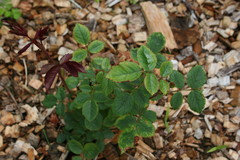
it is lacking something? Or is this a virus? This is an own-root rose I ordered from Rouge Valley roses.strawchicago z5
Original Author8 years agolast modified: 8 years agoHi Rgardening: I like your profile picture, the rose next to you ... what's its name? Thanks for the info. Your pic. looks like iron deficiency. An excerpt which I posted up there: "Iron-deficient fields, when viewed from a distance, exhibit irregularly-shaped yellow areas. Because iron is not translocate in the plant, deficiency symptoms appear on the new growth first. Iron deficiency on individual plants is characterized by yellow leaves with dark green veins (interveinal chlorosis)."
Best iron source I have tested is cocoa mulch, but need to watered in IMMEDIATELY, otherwise the smell attract dogs & dogs get sick eating that. Second best iron source is Red lava rock, but one need to soak that in rain water overnight, then hit with a hammer and it crushes easily. Third best is blood meal, rich in iron & nitrogen. Fourth best is chelated iron, as in soluble-fertilizer. Last, and worse is iron sulfate, that's SHOUD NOT be used with pH above 7, since it burns roots.
Since your own-root is small, it can use some blood meal, NPK 12-0-0, high in nitrogen and has iron. I would apply a small amount of blood meal, no more than 2 Tablespoon, too much blood meal would make the rose NOT flowering for the rest of the year. Chemical Ammonium sulfate would green that up by lowering soil pH, I already tested that .. it wasn't as good as blood meal. Another option is to look for a balanced & soluble fertilizer highest in chelated iron. Good luck, and please update. Thanks.
msdorkgirl
8 years agoHope your rose does well, allaboutrose... are you able to check ph? Two months is a long time to wait and asking the forum and getting answers, especially from Straw, will surely get that rose a kickstart. :) After 3 months of fretting over an El Catala own root not doing anything, I ended up giving it to a friend and he managed to get it to bloom twice by repotting and applying his magic green thumbs to counteract my black ones.
Thank you Straw, for your thorough answer yet again ... of all the things I've purchased, blood meal has not been on my list (I went the iron sulfate route and then promptly gave it away because of the metal smell that I disliked intensely). Besides iron and the obvious nitrogen boost, are there other reasons one should add bone meal? In all the readings I've done, bone meal hasn't been generally recommended for roses since everyone is all about getting flowers.
It would be interesting to get a list and explanation of items you have currently in your garden arsenal.strawchicago z5 thanked msdorkgirlallaboutrosegardening
8 years agoThank you Straw! That's what I thought, but I have never seen rose mosiac virus, and hoped it wasn't that! Thanks so much for your prompt answer! The lady who commented before me is right; you are so helpful in this forum! Oh... the rose in my pic is an old Garden Rose; 'Seven Sisters'. I love it, even though it blooms only once a year.
I'll use the blood meal, don't know where to get the lava rock or cocoa mulch. I'll keep you posted.
Thanks again!strawchicago z5 thanked allaboutrosegardeningstrawchicago z5
Original Author8 years agolast modified: 8 years agoThanks to both of you: Msgirl and Rgardening ... without your questions I would not bother to dig up info., which help my garden as well. I love that "Seven Sisters" OGR in Rgardening's profile. If you google "iron in chocolate", you'll see "According to the website, Nutritiondata.com, a one ounce serving of dark chocolate contains 19 percent of the US RDA for iron. Yet an ounce of beef sirloin only contains 3 percent.
Read more: http://www.care2.com/greenliving/iron-dark-chocolate-contains-more-than-beef.html#ixzz3eZfYM9gY
That's why women before their period crave for chocolate .. besides high-iron, chocolate is also high in magnesium. Cocoa mulch works well in treating iron-deficiency. Cocoa mulch, being small particle, works immediately within a week. Red-lava-rock is sold cheap everywhere: Walmart, HomeDepot. Menards, Lowe's ... but it takes forever to work, like 1-year for large chunks.
Forget to mention that Kelp has 2% calcium and 2% iron. I tested Kelp before: worked great in greening up tomato & roses, plus more blooming & deeper colors. Soluble Kelp worked faster than blood meal in greening up.
With regard to Msgirl's question on bone meal: works great is you have acidic soil (pH below 7). Bone meal can't break down when soil is alkaline. Some info. I posted in March, 2014:
Here's the link to U. of Kentucky research on Organic Fertilizers & Composts in tomato and pepper seedlings. Their conclusion: Fish emulsion NPK 5-1-1 and Omega 6-6-6 (blood meal, bone meal, sulfate of potash) are effective fertilizers, coming second to chemical fertilizer with higher nutrients NPK 20-10-20. The best growth was achieved by using Peter's 20-10-20 at 1/2 teaspoon per gallon of water, 3 times a week. This was done in greenhouse environment.
The second best growth was with Organic Omega 6-6-6 (blood meal, bone meal, sulfate of potash) at a rate of 1 teaspoon per gallon of water, 3 times a week. Third best growth is fish emulsion. Organics most likely fare better in outdoor soil, where there're microbes, rain, and sun to break-down materials for plants.
Cow manure, worm casting, and horse manure came last in performance. They concluded that perhaps these are not fully composted, and the pH of cow manure is too acidic, below 5, and the pH of horse manure is too alkaline, above 8.
Here is a link that might be useful: U. of Kentucky on organic fertilizers and composts
The first link I posted in this thread is worth looking into: http://www.atlantishydroponics.com/info/nutrient-deficiency-symptoms-in-plants
The above link shows what's in excess will cause deficiency in another element. My soil is tested exceedingly high in magnesium (rock hard & sticky alkaline clay) ... yet the soil test recommended adding gypsum (calcium sulfate). The reason? Excess magnesium cause a deficiency in calcium. The above link also shows excess phosphorus causes many deficiencies: iron, zinc, copper, and manganese. Excessive calcium will induce a potassium and boron deficiencies. Excessive calcium, nitrogen, and salt will induce a potassium deficiency. If the growth of plant is thin and spindly, it's a nitrogen deficiency. But if the plant doesn't bloom, it's a potassium and phosphorus deficiency. Too much nitrogen will induce potassium & phosphorus deficiency, and zero blooming.
If you use blood meal at NPK 12-0-0, it's best to use bone-meal NPK of 3-15-0 at 1/2 amount of blood meal, and sulfate of potash NPK 0-0-50 at 1/4 the amount of blood meal. 50 divided by 12 gives 4.2. Then you'll achieve the same result as Omega 6-6-6 (blood meal, bone meal, and sulfate of potash) in U. of Kentucky research. Personally I'll go with soluble kelp, since it has MANY trace elements besides iron .. 2% of both iron and calcium, plus 1% of vitamin C (promote plant growth):
http://nutritiondata.self.com/facts/vegetables-and-vegetable-products/2617/2
allaboutrosegardening
8 years agoYou sure know your stuff StrawChicago! O.k. more questions; (if you don't mind, and would be so kind!) My neighbor sells Lama manure (cheap) is it good for roses? And what about egg shells? I have a container of dried, ground egg shells. Oh, and one more,(please...) Coffee grounds? Heading out to give my little rose some blood meal.....
Thanks so much!
strawchicago z5
Original Author8 years agoHi Rgardening: For Ilama manure, see an excerpt from link below:
David (Texantrail) stated: "I've had my llama manure analyzed. It had an NPK rating of 1.5-.8-.7 This rating came back from Texas A&M University. I've also had it analyzed by the Texas Plant and Soil Lab in Edinburg, TX. http://www.tpsl.biz They stated it is high in calcium, magnesium, nitrate & phosphate. Salts are a little high for germination and seedlings with direct applications, but mixed with the soil at about 1:4 maybe a little less, shouldn't be any problems. " David (Texantrail).
http://www.helpfulgardener.com/forum/viewtopic.php?t=10678I would ask your neighbor if he/she uses any antibiotics or de-worming medication for their Ilama. Horse manure kept my roses clean, but cow-manure was BAD: major BS-breakout, thanks to the antibiotics that killed beneficial bacteria. The de-worming medications isn't bad, since that gets washed off with rain, but the antibiotic medications stay put in their feces.
Egg shells is lime (calcium carbonate). I threw egg shells in my compost pile, and after 1 year, it hasn't decompose. That would be beneficial in the planting hole (where roots can secret acid to access), but won't decay much on top. Coffee grounds? I threw a bunch of espresso grounds from Starbucks on my rhododendrons .. and that gave pink-stripes to their leaves. Espresso ground is much higher in caffeine can coffee ground.
I tested the pH of coffee grounds and it was a buffer: neutral pH. Coffee ground is high in nitrogen NPK 2-0.3-0.7. Compare that to Ilama manure NPK of 1.5-0.8-0.7 ***** The Ilama manure is higher in phosphorus .. that helps with blooms, but the coffee ground advantage is zero-salt.
My kid was low in hemoglobin since she was an infant .. she was on iron drops as a baby. She took iron-pills for a while, then we bought this seaweed snack from Trader's Joe, which has 8% vitamin A, 2% iron, and 20% vitamin C. She's addicted to that seaweed, it really helps with her iron-deficiency. I start taking NOW kelp tablets this summer, it really helps with my hypothyroid: I sleep better & have more energy when I take Kelp.
I tested Pennington Alaska pellets fertilizer with blood meal & kelp & fish meal & sulfate of potash NPK 4-6-6, and it greened up my tomato immediately. It's sold for $7.97 at HomeDepot, also at Menards. It's a more balanced fertilizer than blood-meal alone. It's most effective when I made tea: soak the pellets in a bucket in hot sun for a few days .. the water is good stuff, but the left-over-solids is quite acidic, that need a buffer like dolomitic lime on top to prevent black spots from germination.
strawchicago z5
Original Author8 years agolast modified: 8 years agoThe reason why soluble Kelp (seaweed) is so effective in greening up plants, plus growth boost is: Seaweed has vitamin C, essential for plant growth. Also vitamin C is needed to maximize iron absorption. My kid takes her iron pill with a glass of orange juice to enhance iron-absorption. See excerpt from link below:
" Vitamin C can nearly double the absorption of nonheme iron, according to Virginia Commonwealth University. Phytochemicals in some fruits, vegetables, coffee, tea and wine can also inhibit absorption of nonheme iron." http://www.livestrong.com/article/195055-does-vitamin-c-increase-iron-absorption/
For that reason, coffee isn't good for pale plants, since it blocks the absorption of iron. That's why my pale rhododendron got pink stripes when I gave it espresso-grounds, instead of getting darker-green.
Jim posted very vigorous & healthy leaves on his roses using fish and kelp in Roses & Stuff #2 below. But that did not prevent his roses from black spots ... perhaps from lowering pH, and lack of anti-fungal agents.
http://forums.gardenweb.com/discussions/3168737/roses-and-stuff-2?n=60
strawchicago z5
Original Author8 years agolast modified: 8 years agoFound a link that differentiate between magnesium deficiency and Interveinal chlorosis as in iron, zinc, and manganese deficiencies. Click on the link, and scroll all the way down to see the picture of magnesium deficiency:
http://extension.arizona.edu/sites/extension.arizona.edu/files/pubs/az1106.pdf
The above link stated Calcium deficiency as "New leaves (top of plant) are distorted or irregularly shaped. Causes blossom-end rot."
Also nitrogen deficiency as "yellowing of older leaves, and the rest of the plant is light green." And magnesium deficiency as "Older leaves turn yellow at edge, leaving a green arrowhead shape in the center of the leaf".
strawchicago z5
Original Author8 years agolast modified: 8 years agoMy soil is tested exceedingly high in magnesium, but low in manganese. The below link is the best I have seen, much more comprehensive than University Extensions:
http://www.gardeningknowhow.com/garden-how-to/soil-fertilizers/fixing-magnesium-deficiency.htm
"Heavy rains can cause a deficiency to occur by leaching magnesium (Mg) out of sandy or acidic soil. In addition, if soil contains high amounts of potassium, plants may absorb this instead of magnesium, leading to a deficiency.
Plants that are suffering from a lack of magnesium will display identifiable characteristics. Magnesium deficiency appears on older leaves first as they become yellow between the veins and around the edges. Purple, red or brown may also appear on the leaves."
And for Manganese-deficiency (Mn), which is common in my alkaline heavy clay: it's diffused-yellowing of YOUNGER leaves. "This role of manganese in plants is extremely crucial. Deficiency, which is common in soils that have neutral to high pH or a substantial deal of organic matter."
http://www.gardeningknowhow.com/garden-how-to/soil-fertilizers/manganese-in-plants.htm
The above link points out the difference: "Magnesium is a part of the chlorophyll molecule. Plants that are lacking in magnesium will become pale green or yellow. A plant with a magnesium deficiency will show signs of yellowing first on the older leaves near the bottom of the plant. However, manganese is less mobile in a plant than magnesium so that the symptoms of deficiency appear first on young leaves."
Magnesium deficiency is also confused with potassium deficiency. An excerpt from below link on potassium deficiency: "When severe potassium deficiency happens: The leaves, especially older leaves, may have brown spots, yellow edges, yellow veins or brown veins."
http://www.gardeningknowhow.com/garden-how-to/soil-fertilizers/plants-potassium.htm
Some sources of potassium: banana peels, wood ash, red lava rocks, cocoa mulch and greensand.
strawchicago z5
Original Author8 years agolast modified: 8 years agoI cut roses for the vase, I can tell when roses are deficient in calcium: blooms don't last long in the vase, the petals shatter when I tried to cut them off from the bush. When I mulched my roses with horse manure (has shell-lime added), my cut-roses lasted long in the vase. Lime is best added in SMALL AMOUNT in slow-released form after heavy rain, so it doesn't cause a steep rise in pH. The below link explains how high potassium fertilizer can induce calcium deficiency. I saw calcium deficiency when I piled up too much red-lava-rocks (high in potassium). Here's an excerpt from below link: http://www.smart-fertilizer.com/articles/calcium-in-plants
" Presence of competing ions - calcium competes with other positively charged ions, such as sodium (Na+), potassium (K+), and magnesium (Mg+2). Applying too much of these positively charged ions might decrease calcium uptake by plants. Sodium ions can replace the adsorbed calcium, damage soil structure and decreases calcium availability."
**** From Straw: Sodium ions, or salt is plenty in chemical fertilizer. That's why gypsum (calcium sulfate) is known to de-salt saline soil. Google "pictures of calcium deficiency" and you'll see brown spots on leaves, that's the advance stage.
More from the link above: "Calcium deficiency is usually caused due to low calcium availability or due to water stress which results in low transpiration rates. The symptoms of calcium deficiency include curling of young leaves or shoots scorching or spotting on young leaves, poor growth, leaf tip burns, stunted roots, and damage to fruit."
strawchicago z5
Original Author8 years agoFound another link that describes nitrogen-deficiency well. Here's an excerpt from below link: "The earliest symptom of nitrogen deficiency is yellowing of lower leaves. It will have a rather uniform yellowing that is more pronounced on the older leaves inside the plant. The leaves then become smaller and thinner and turn quite bronze in winter. "
http://www.clemson.edu/extension/county/laurens/mg/askmg/081_boxwood_maintenance.pdf
strawchicago z5
Original Author8 years agolast modified: 8 years agoIn my search for symptoms of phosphorus excess, I came across this link, which is VERY comprehensive on all nutrients, including what's in excess can cause harm. See excerpts from below link. In my garden I see zinc deficiency, when I applied too much lime, or too much phosphorus. Phosphorus deficiency? don't see that in my alkaline clay, pH 7.7 soil.
https://www.hydroponics.net/learn/deficiency_by_element.asp
Zinc Deficiency: Chlorosis may accompany reduction of leaf size and a shortening between internodes. Leaf margins are often distorted or wrinkled. (high phosphorus or high calcium will induce zinc deficiency).
Phosphorus Deficiency: Plants are stunted and older leaves often dark dull green in color. Stems and leafstalk may turn purple. Plant maturity is often delayed.
Calcium Deficiency: Young leaves are affected first and become small and distorted or chlorotic with irregular margins, spotting or necrotic areas. Bud development is inhibited and roots may be underdeveloped or die back. Fruit may be stunted or deformed.
jim1961 / Central Pennsylvania / Zone 6
8 years agoStraw,
Have you run into any sites with good pics of deficiencies along with the descriptions?
strawchicago z5
Original Author8 years agolast modified: 8 years agoHere's the link with pictures that I posted at the beginning of this thread. From that link, I identify calcium-deficiency in my tomatoes, gave them gypsum, and got firm tomatoes without cracks. Previous years my tomatoes, esp. cherry cracked in the rain.
Picture of nutrient deficiencies in plants
I don't like the above link since it shows EXTREME & exaggerated deficiencies. The below link from U. of Florida shows an excellent pic. of zinc deficiency, which I see often in my roses when I applied too much calcium via gypsum, or phosphorus via bone-meal. Note the smaller & pale leaves in pear tree due to zinc-deficiency:
http://hort.ifas.ufl.edu/database/nutdef/pic18.shtml
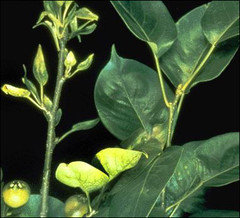
Excellent copper-deficiency pic. in rose-leaves:
http://hort.ifas.ufl.edu/database/nutdef/pic23.shtml
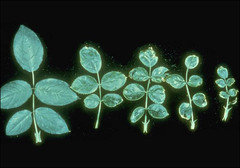
Here's how iron-deficiency in rose looks like:
http://hort.ifas.ufl.edu/database/nutdef/pic57.shtml
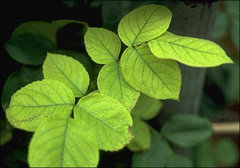
Here's a large data base of pics. from U. of Florida, worth looking into:
http://hort.ifas.ufl.edu/database/nutdef/index_element_common.shtml
jim1961 / Central Pennsylvania / Zone 6
8 years agolast modified: 8 years agoI've seen iron deficiency quite a few times when our soil was waterlogged from mulch keeping it to wet. That's how I come to know I had a problem. Because without any action be taken the conditions would clear up by itself during drier weather patterns... So since removing mulch I have not seen that happen ever again...
strawchicago z5
Original Author8 years agolast modified: 8 years agoIf the entire plant is pale, then it's sulfur deficiency. If the oldest leaves are most pale, then it's nitrogen-deficiency. BOTH nitrogen and sulfur are leached out with heavy rain, along with potassium (3 mobility). Large excerpt from below site:
http://www.plantsdb.gr/en/general-cultivation/fertilizing/457-nutrient-deficiencies-and-toxicity
Whole plant is affected, starting from the older leaves.
- Nitrogen
- Phosphorus
- MolybdenumSymptoms restricted to the older leaves:
- Potassium
- Magnesium
- ChlorideSymptoms restricted to the newer leaves:
- Calcium
- Sulphur
- Iron
- Zinc
- Boron
- Manganese
- CopperNitrogen Deficiency Caused by:
- High levels of Phosphorus or Potassium & Waterlogged soil.- Yellowing of the leaves, that starts from its tip. Older leaves are affected first
- Thin young shoots & Stunted growth & Small sized leaves &
- Short internodes.Too much nitrogen: caused by dry conditions & Stems are dark green.
- Increased susceptibility to diseases & Decreased flower and fruit production.Phosphorus Deficiency Caused by:
- Too high (>7.5) or too low (<5.5) soil pH and Low temperature.
- Insufficient aeration of the soil or Waterlogged soil.
- Low soil organic matter & High Zinc levels.- Older leaves turn dark green with pink to red blotches, especially on their lower side. Newer leaves are affected later on.
- Similar discoloration of older stems & Root growth slows down
& less bloomsToo much will induce: Nitrogen, Zinc, Iron or Manganese deficiency.
Potassium Deficiency Caused by:
- Low cation-exchange capacity (CEC) of the soil (eg. soil high in organic matter).
- High Magnesium or Calcium levels & Dry conditions.
- Low pH and increased salinity & Compacted soil. & Low temperature.- Yellowing and necrosis of the lower leaves, starting from their tips or their margins & Decreased blooming & Thin young shoots.
Too much will causes Nitrogen or Magnesium deficiency.
Calcium Deficiency Caused by:
- Low soil pH & Low soil cation-exchange capability (CEC).
- High levels of Magnesium, Sodium or other cations.- Young leaves are distorted, with curled margins and tip or with brown spots.
- Old leaves are dark green.& Terminal bud necrosis.
- Stunted root growth & Blossom-end rot.Too much
- Causes deficiency Magnesium, Potassium, zinc, iron & others.Magnesium Deficiency Causes by:
- Low soil pH
- High Manganese or Potassium levels.
- Low cation-exchange capability (CEC) of the soil.
- Low temperature.Yellowing of the old leaves that starts from their margins and spreads between their veins.
Sulphur Deficiency Causes by Soil low in organic matter.
- Easily washed away in sandy soils.
- Low temperature.
- Insufficient drainage.- Light yellowing of the youngest and later on the oldest leaves & stunted plant.
Too much: causes pH leves to drop.
Iron Deficiency Causes by High soil pH and salinity.
- High Phosphorus, Manganese, Calcium, Molybdenum or Zinc levels.
- Soil low in organic matter & Insufficient drainage.Leaves become yellow or near white between their veins. Stunted growth.
Too much Causes:
- Zinc or Manganese deficiency & Very low pH.Zinc Deficiency Causes by High pH or High Phosphorus or Copper levels.
Soil low in organic matter.- Yellow spots or diffuse chlorosis between leaf veins.
- Small leaves with irregular shape & Necrosis and defoliation.
- Short internodes & Poor flower and seed production.Manganese Deficiency Caused by:
- High pH & Soil high in organic matter.
- High levels of Iron, Chloride or heavy metals & Waterlogged soil.- Leaves become yellow or near-white between their veins. Discoloration is more intense than Iron deficiency.
- Grey spots, especially near the base of the leaves.Too much Caused by Low pH (<5.5).
- Older leaves become chlorotic or necrotic. & Affected root growth.
Copper Deficiency Caused by:
- High pH & high in organic matter.
- Waterlogged soil & Increased Zinc, Nitrogen and Phosphorus levels.- Young shoots are distorted or wilting.
- Younger leaves become yellow between their veins. Later on their vein become yellow too. Poor or no blooming. & Stunted growth and weakened defense.strawchicago z5
Original Author8 years agolast modified: 8 years agoExcellent link with pictures of deficiencies. Learn something new: over-liming will also cause zinc deficiency: smaller & pale leaves and shorter interval between nodes. See link:
msdorkgirl
8 years agoIf I can find a time during the day when it's not raining ... I'll post a picture of a couple of my plants that have good growth but new sections with vigorous but paler leaves. Since this is happening with the newer plants and not the older ones, I am assuming that the newbies just need more.
I'll also be posting SAD Paul Neyron so you folks can tell me what to do with him given what materials I have (prune or repot or use a specific fertilizer I already havr, etc)
I still haven't found the time to mix up the Growmore Rose Food (8-10-8) to feed all the roses by foliar and probably blending the Marine Cuisine and Rosetone together as a thin layer of soil food. But I think I want to try for the Fall Rose Show so cross my fingers I'll have something worthwhile to submit.
strawchicago z5
Original Author8 years agolast modified: 8 years agoHi Msgirl: Growmore Rose food at NPK 8-10-8 for foliar feeding. Yes to the micronutrients it contains, but I'm not sure about high phosphorus at 10. The high phosphorus will zap out zinc, iron, and manganese, plus attract thrips.
Granular high-nitrogen Marine Cusine NPK 10-7-7 and Rosetone sounds good for rainy weather. Phosphorus at 7 can lead to build-up in soil, since phosphorus doesn't get leached out, its mobility is a 1.
What I learn from our 3-months (May & June & July) of constant heavy rain? I supplied them with red-lava-rock (high potassium) plus chicken manure which caused tons of buds on Duchess de Rohan. But 90% of her buds did not open, thanks to botrytis (browning of buds). I DID NOT give it gypsum (calcium sulfate) so there wasn't enough calcium to help the buds open properly. I didn't realize calcium leach out during heavy rain.
Funny that my present flush (hot August) of Evelyn is twice better than her spring flush: more buds, and better-blooms. In August I gave Evelyn pea gravel, plus gypsum, plus dolomitic lime. Blooms have more petals. I have Comte de Chambord in a vase, its bloom lasts twice-longer than during spring. I gave Comte gypsum, that prolong the vase life, plus more petals. All watering this year was done through my 3 rain-barrels, with acidic rain water, pH 5.6.
Today, August 27, I will use tap water for the 1st time this year, but I'll going to bring its pH down with sulfate of potash & gypsum.
strawchicago z5
Original Author8 years agolast modified: 8 years agoFrom Wikipedia: " Acidic, sandy, or coarse soils often contain less calcium. Uneven soil moisture and overuse of fertilizers can also cause calcium deficiency. At times, even with sufficient calcium in the soil, it can be in an insoluble form and is then unusable by the plant or it could be attributed to a "transport protein".[2] Soils containing high phosphorus are particularly susceptible to creating insoluble forms of calcium.
Calcium deficiency symptoms appear initially as localized tissue necrosis leading to stunted plant growth, necrotic leaf margins on young leaves or curling of the leaves, and eventual death of terminal buds and root tips. The new growth and rapidly growing tissues of the plant are affected first. The mature leaves are rarely if ever affected because calcium accumulates to high concentrations in older leaves.[3]
Here's a picture of calcium deficiency from below site: picture of calcium deficiency necrotic spots on mid and older leaves, roundish but irregular in shape and symmetrically arranged. - fibrous root growth is inhibited.
- Occurs in light-textured acid soils, with low cation exchange capacity. May be exacerbated by heavy application of potassium fertiliser (which can inhibit calcium uptake).
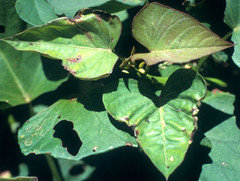
Other factors that limit the availability of calcium: " Calcium forms insoluble compounds with other elements in soil, such as phosphorous. Calcium competes with other positively charged ions, such as sodium (Na+), potassium (K+), and magnesium (Mg+2). Applying too much of these positively charged ions might decrease calcium uptake by plants.
http://www.smart-fertilizer.com/articles/calcium-in-plants
From gardening know how: " A calcium deficiency plant is notable for its stunted growth in new leaves and tissues. Brown spots may appear along the edges and grow toward the center of the leaves."
http://www.gardeningknowhow.com/garden-how-to/soil-fertilizers/soil-and-calcium.htm
strawchicago z5
Original Author8 years agolast modified: 8 years agoSince copper is a strong fungicide. Here's an excerpt from below link on copper deficiency:
" Plant shows a lack of growth; petioles bend downward; leaves appear light green and become dry at the tips; - See more at: http://www.biology.lifeeasy.org/1223/what-are-the-deficiency-symptoms-of-copper-in-plants#sthash.rk3hp95Y.dpuf
Here's a picture of copper deficiency, taken from below link:
Deformities, puckering and holes in young leaves.
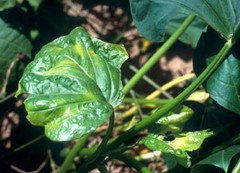
Excellent copper-deficiency pic. in rose-leaves:
http://hort.ifas.ufl.edu/database/nutdef/pic23.shtml
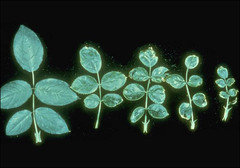
msdorkgirl
8 years agoNotice Happy Child with light green new growth.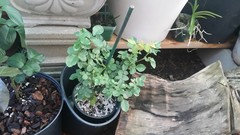
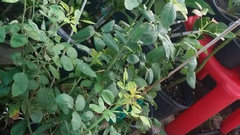
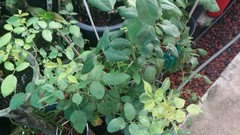
Paul Neyron also showing light green for the new shootsI think this is Claire Austin or it might be Tranquility ... but still very light green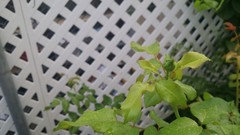
I really do want to spend some time giving them a good feeding ..
Hopefully this weekend is conducive for that and the weather is pleasant enough.
jim1961 / Central Pennsylvania / Zone 6
8 years agoI have some roses where the new growth is lighter green but they green up with age...
strawchicago z5 thanked jim1961 / Central Pennsylvania / Zone 6strawchicago z5
Original Author8 years agolast modified: 8 years agoI should post VERY LIGHT & almost yellowish growth on my Prairie Harvest in a pot with recent 10-hours-heavy rain. That pot has poor drainage, plus too much phosphorus via NPK 4-10-7. Too much rain releases phosphorus from the soil. But in dry period, when one waters with alkaline tap-water (with UNSTABLE calcium hydroxide), that will bind up with phosphorus, making it less available. When it stops raining, I'll take a picture to see if it's sulfur deficiency or zinc.
Zinc Deficiency Causes by High pH or High Phosphorus or Copper levels.
Soil low in organic matter.- Yellow spots or diffuse chlorosis between leaf veins.
- Small leaves with irregular shape & Necrosis and defoliation.
- Short internodes & Poor flower and seed production.Too much rain also leaches out sulfur, and causes temporary sulfur deficiency until the soil dries out, and plant can uptake nutrients to green up again.
Sulphur Deficiency Causes by Soil low in organic matter.
- Easily washed away in sandy soils. - Low temperature. - Insufficient drainage.- Light yellowing of the youngest and later on the oldest leaves & stunted plant.
strawchicago z5
Original Author8 years agolast modified: 8 years agoHere's a pic. of zinc deficiency in loquat-leaves. Note the young leaves are yellowish & smaller. That's different from iron-deficiency, where the young leaves are pale, but retains their green veins.
http://hort.ifas.ufl.edu/database/nutdef/pic33.shtml
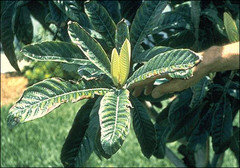
This picture shows best the diffused-yellowing of zinc deficiency, I got that on Queen of Sweden when I put too much triple-super-phosphate in the planting hole.

Below is iron deficiency, note the veins still green on pale-background of young leaves:
http://hort.ifas.ufl.edu/database/nutdef/pic59.shtml

Sulfur deficiency also produces pale young leaves, but the leaves ARE NORMAL size, rather than being smaller like in zinc-deficiency. Sulfur deficiency also occurs when there's too much rain that leaches out sulfur, that's only temporary, and the leaves become green again when it gets fertilized as in ammonium sulfate. Foliar-spraying with ammonium sulfate is most effective. Below is sulfur deficiency in Chinese cabbage. Below link has excellent info. on foliar spraying of all nutrients, including ammonium sulfate (21% nitrogen and 24% sulfur)
http://www.aardappelpagina.nl/explorer/pagina/fertilizersupl.htm

strawchicago z5
Original Author8 years agolast modified: 8 years agoI went out in heavy rain to check my pots. Yes, it's sulfur deficiency in Prairie Harvest, that one likes it acidic, since I put cocoa mulch on all pots last month. They all hated that, broke out in rust, except for Prairie Harvest. Sulfur is released by decayed organic matter (such as cocoa mulch & alfalfa) ... too much sulfur will lower the pH. Sulfate of potash has 21% sulfur, gypsum has 17% sulfur. I'm leaning toward GRANULAR gypsum over lime for heavy rain.
jim1961 / Central Pennsylvania / Zone 6
8 years agoI never seen rust on roses here... I thought that was a out west thing like California, etc... I didn't know Chicago got rust... Since we do not get it here I never researched it...
strawchicago z5
Original Author8 years agolast modified: 8 years agoWe don't have rust here unless I induce it, through cocoa mulch at pH 5.4, perfect for rust. This is the 2nd time I induced rust through cocoa mulch .. it stays wet and grows this orange-fungus which I posted on my tomato one time. Rust is caused by wet-medium (wet cocoa much) high in manganese, at pH 5.4 to 5.8, and low in potassium (through my using soluble gypsum, which drives down potassium).
I never see rust at the 2 rose parks (Cantigny with 1,200 roses, and Chicago Botanical garden with 5,000). I go to both parks frequently for the past 2 decades. It's only when I test cocoa mulch, that's when rust occurs. Both rose parks don't use any mulch, just bare dirt.
strawchicago z5
Original Author8 years agolast modified: 8 years agoRe-post the info. from the other thread:
The problem with lime? Its high pH kills the soil bacteria that fixes nitrogen, so lime UNDO the effect of nitrogen-fertilizer like alfalfa. I put lime in Pink Peace's planting hole, since the soil was previously occupied by a large bush, plus I wanted to tone-down its gaudy color. The result? Calcium & other nutrients deficiency in young leaves, along with less petals and flowers that don't last long. Calcium could not be released since the pH is too high in the planting hole. Will have to dig Pink Peace AGAIN after its 3rd flush.
Grafted Pink Peace gives me hell, compared to much-cleaner-own-root. I dug it up 4th of July since it black spotted on me, fixed the hole with compost & lime, it became pale & less petals after that. It's really hard to achieve balance of nutrients, so I'm better off using slow-released balanced stuff: red-lava-rock & pea gravel, compost, alfalfa hay.

My GRAFTED Pink-Peace black spots be it wet or dry. Above pic, it's a calcium deficiency, since the young leaves are, "New leaves (top of plant) are distorted or irregularly shaped. Causes blossom-end rot." see link below:
http://extension.arizona.edu/sites/extension.arizona.edu/files/pubs/az1106.pdf
I get tons of blossom-end-rot on my cherry-tomato: the one I forgot to put gypsum in the planting hole. Gypsum is questionable on top, but great in the planting hole, since it's evenly distributed, rather than gunking on top to burn roots. Below is a good chart:






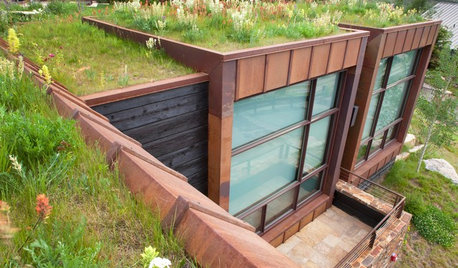










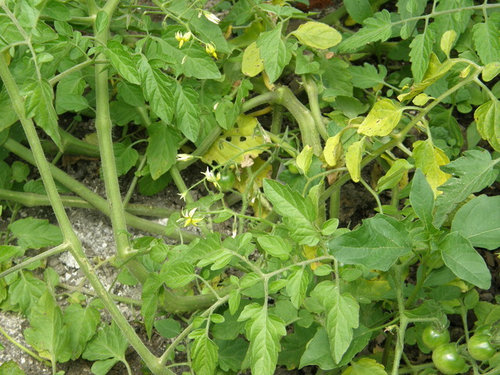
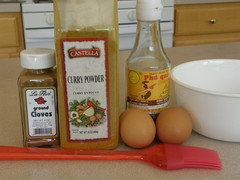

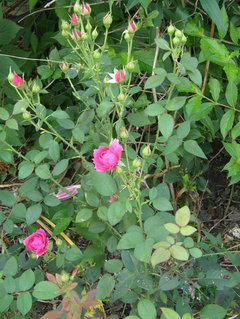
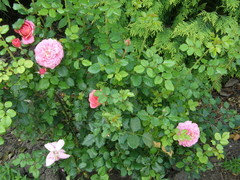
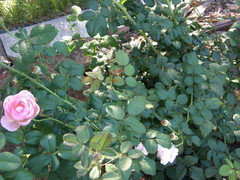



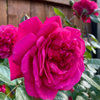

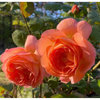
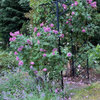
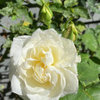
enchantedrose